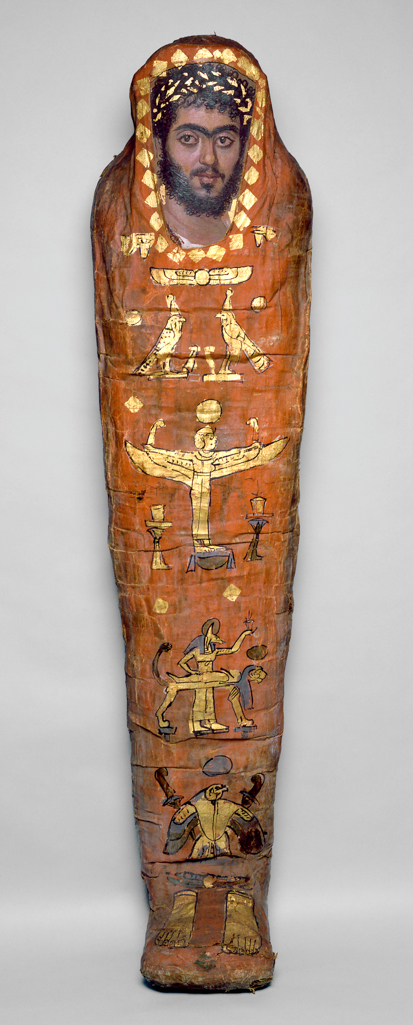

Object number: E.63.1903
Description: Red shroud mummy with painted wood panel over face from El-Hiba, Egypt, AD 100-150. Gift of the Egypt Exploration Fund. The mummy is supported on two narrow wooden planks, which are tied together with bandages. This structure and the mummy were wrapped together in a shroud made of a single piece of plain-weave linen, folded neatly over the feet but gathered more roughly at the top of the head and stuck in place. The shroud is painted in bright scarlet made from a mixture of red lead, chalk/calcite and carbon-based black, and applied in a beeswax medium. The decorative elements are outlined in grey paint (lead white, yellow ochre and carbon-based black in a wax and oil medium) and completed with purple paint (made from carbon-based black, iron oxide red, calcite and lead white), copper-based green frit, and gold leaf, with final detailing in black. The portrait panel sits in an opening cut into the front of the shroud. The painting was executed in a beeswax medium, using a pigment palette similar to that found in the shroud decoration. The paint was applied with a brush along with a variety of tools to build up texture.
Measurements: H. 162cm W. 34cm D. 25cm
Analysis: Analysis carried out at the Getty Conservation Institute on red lead pigment on several Roman Egyptian red mummy shrouds has shown that the pigment was sourced from the Roman silver mines at Rio Tinto in Spain, where it was a by-product of silver refining.
CT scanning showed that the man was about 174cm tall and probably in his early twenties, but did not reveal any obvious cause of death. The body is lying with the arms by the sides and hands on the upper thighs, the head pushed forward to rest on the chest. Disruptions to the spine and pelvic area suggest that the brain was removed through the back of the neck and other organs pulled out between the legs. There is considerable crushing and curvature of the spine, and the shoulders are dislocated. All this damage appears to be post-mortem, possibly due to tight wrapping exacerbated by the body’s being in a state of decay when it was mummified. By the Roman period, the practice of mummification was in decline, with a greater reliance on large quantities of resin to preserve rather than careful drying and preparation of the body.
Commentary: Mummy portraits like this were placed over the faces of the mummies of wealthy people during the Roman Period in Egypt (between the 1st and 3rd centuries AD). They are renowned for their lifelike appearance and were painted onto wooden boards. Around 1000 portraits like this survive today. Some are inscribed with Greek names. They mostly come from the Faiyum.
Other relevant objects in the Museum’s collection: E.102.1911, E.5.1981, E.2.1888, E.111.1932, E.W.50, E.W.48, E.110.1891, E.W.52.

Red shroud mummy from El-Hiba, Egypt. Fitzwilliam Museum: E.63.1903.